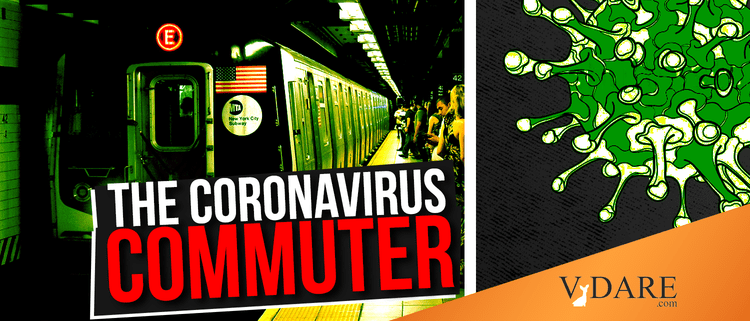 Other cities rely more on buses, but NYC has a huge number of buses too.
Other cities rely more on buses, but NYC has a huge number of buses too.

By Steve Sailer
04/10/2020

So, the monthly excess death toll in NYC in the month up through April 4, 2020 is about twice as bad as September 2001.

From The New York Times a couple of days ago:
41 Transit Workers Dead: Crisis Takes Staggering Toll on Subways
The M.T.A. has been criticized for its response to the outbreak. Now a staffing shortage has made it difficult to keep even a diminished system running.
By Christina Goldbaum, April 8, 2020
At least 41 transit workers have died, and more than 6,000 more have fallen sick or self-quarantined. Crew shortages have caused over 800 subway delays and forced 40 percent of train trips to be canceled in a single day. On one line the average wait time, usually a few minutes, ballooned to as high as 40 minutes.
Ideally, the NYC subway system could respond to an epidemic by running more trains to reduce crowding. But illness among its workers means fewer, more jammed trains, which increase the likely infectiousness risk of each.
I hadn’t realized how the NYC subway is an order of magnitude busier than the biggest “heavy rail” (i.e., subways or elevateds with their own right of ways) systems of the next tier, D.C. and Chicago.
| City/Area served | Annual ridership | Avg. weekday ridership | System | Rider. per mile |
| (2019)[1] | (Q4 2019)[1] | length | ||
| New York City | 2,274,960,100 | 9,117,400 | 245 miles (394 km)[2] | 37,214 |
| Washington, D.C. | 237,701,100 | 816,700 | 117 miles (188 km)[4] | 6,980 |
| Chicago | 218,467,000 | 695,300 | 102.8 miles (165.4 km)[5] | 6,764 |
| Boston | 152,339,700 | 475,300 | 38 miles (61 km)[6] | 12,508 |
| San Francisco Bay Area | 123,510,000 | 421,100 | 112 miles (180 km)[7] | 3,760 |
| Manhattan; Hudson County, and Newark | 90,276,600 | 306,700 | 13.8 miles (22.2 km)[10][11] | 22,225 |
| Philadelphia | 90,240,800 | 329,200 | 36.7 miles (59.1 km)[14][15] | 8,970 |
| Atlanta | 63,998,500 | 175,338[note 5] | 47.6 miles (76.6 km) | 3,684 |
| Los Angeles | 41,775,100 | 130,900 | 17.4 miles (28.0 km)[20] | 7,523 |
| Miami | 18,073,100 | 62,600 | 24.4 miles (39.3 km)[21] | 2,566 |
| Philadelphia, southern New Jersey | 11,107,500 | 38,400 | 14.2 miles (22.9 km)[23] | 2,704 |
| Staten Island (New York City) | 7,741,000 | 28,500 | 14 miles (23 km)[2] | 2,036 |
| Baltimore | 7,325,500 | 36,600 | 15.5 miles (24.9 km)[25] | 2,361 |
| Cleveland | 5,958,000 | 15,900 | 19 miles (31 km)[27] | 837 |
| San Juan | 5,233,900 | 20,300 | 10.7 miles (17.2 km)[29] | 1,897 |

Basically, NYC has the fewest people with their own private cars.
My guess is that dangers of infection correlate with number of people standing in the mass transit vehicle and perhaps with straphanging. My vague recollection is subways tend to have more floor space for standing than for sitting, while buses have more floor space devoted to sitting than standing, while commuter trains try to be all sitting.
This unfortunate event will cause some trouble for mass transit enthusiasts.
This is a content archive of VDARE.com, which Letitia James forced off of the Internet using lawfare.